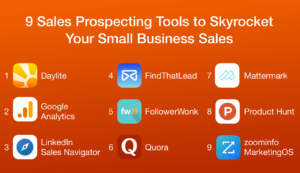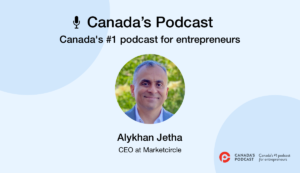Do you want more clients but don’t make the time for getting new business because you hate the idea of prospecting? Sales Expert, Andrea Waltz, has the solution to overcoming that fear so you can start driving growth in your business.
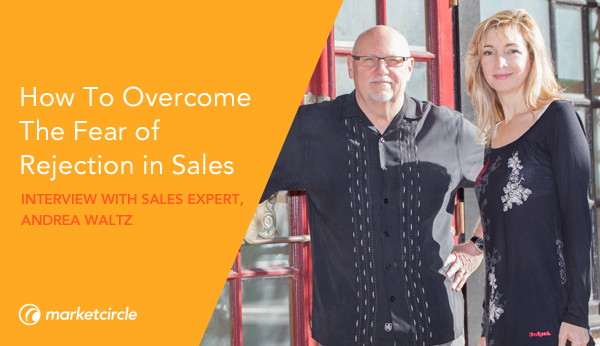
Many business owners struggle to balance their time between helping existing clients and going after new business. But the problem is, without devoting adequate time each day to driving new business, your growth rate can remain stagnant.
Bringing in new business can also be a struggle when you’re afraid of hearing “no”. You’re passionate about your business and helping people, but the idea of cold-calling or prospecting makes you uncomfortable.
We interviewed Sales Expert, Andrea Waltz, to learn how business owners that hate prospecting can overcome their fear of cold-calling and start driving more growth.
Andrea Waltz has years of experience in sales training and after leaving the corporate world, she and her partner, Richard Fenton, started their own sales training program teaching people their Go For No! mindset and strategy. Andrea co-authored the best-selling book Go For No! Yes Is The Destination, No Is How You Get There and specialized in helping salespeople overcome the fear or rejection.
When it comes to selling services, many people wait for prospects to come to them. What’s the biggest issue with this strategy when it comes to getting business?
Andrea: That is one of the biggest issues, especially for small business. When you’re in a small business, you’re the sales person and the provider of the services. It’s a challenge because you have to balance your time. You can’t spend all of your time selling because you have to provide services to your customers, follow up on issues, put out fires, and the list goes on.
The problem with sitting back and waiting for leads is that your future business is out of your control because it’s dictated by your customers. You become a passive order-taker and you have to hope that the phone will ring or that people will walk into your office. That strategy is stressful and puts your growth in the hands of someone else.
The order-taking mindset is troubling. Hoping people find you through word of mouth or over the internet is one way to get business, but there’s a chunk of business to be had by going out and being proactive. I call it telling your story of what you do and how you help people – the problems that you solve– to more people to drive that extra percentage of business and drive growth.
We’ve all heard the term ‘one client reliant’. If you rely on a few clients to sustain your business, you’re putting yourself in dangerous position by relying on that ongoing business.
How can business owners get better at balancing their time between selling and offering their services? Is there a certain ratio or percentage of time that should be spent on prospecting?
Andrea: I think it’s a bit different for everyone but I would say this for sure – even if you can set aside 10% of your day to do prospecting, that can have a big impact on your business. Take that 30 minutes a day or hour to follow up with people or call an existing and happy client and ask for a referral. Those things ,if done consistently, can really pay off.
What I see is that people find themselves in a position where they realize they need new business and they try to get all of that sales and prospecting and outbound selling activity done in one day or a few days. You’re far better off to do follow ups and prospecting consistently everyday.
Prospecting is a similar task like checking emails. We check our emails daily– hopefully not more than a few times a day– and it becomes part of our routine. If you make prospecting a priority that you do for 30 minutes or an hour everyday, then it doesn’t become this overwhelming thing.
Mark Cuban said “Sales solves all problems”. I think sometimes business owners think that if they’re selling they won’t be able to manage new clients. If you’re having a lot of new business, that’s a great problem to have! Maybe you just need to hire on an extra person or a virtual assistant to help you out. Again, that’s a great problem to have.
My advice is to set aside a little bit of time everyday and be consistent. That way you’ll create a steady stream of business and avoid that pressure of having to get new business when existing sales start to dwindle. That’s unnecessary stress that you don’t want. When you’re reaching out to people and telling you story, then you’re not as pressured because you’re not coming at it from a point of desperation. If you make that part of your everyday, it’s much easier on yourself.
You mentioned asking customer for referrals. What’s the best way to approach customers when asking for referrals?
Andrea: So much of what we teach is just a mindset around how you approach things. A lot of business owners are uncomfortable asking customers for referrals. My advice is keep it light and friendly.
In Bob Burg’s book Endless Referrals, he writes that “People do business with people they know and trust.” If you have current clients who know and trust you and have paid for your services, call them up – and it’s key to be transparent and authentic– and explain to them what you’re doing. Tell them you’re looking to add new clients and you’re calling up your best clients to ask who they know that’s in the market for your services.
Try to make it as specific as possible because the more specific you can make the question, the easier it will be for that client to come up with a name or company. They may not know off the top of their head. Most people need to give it some thought. At that point, it’s great to let them know you’ll send them an email reminder to follow up if they’ve thought of anyone. Don’t let it drift. It’s challenging on the spot to come up with someone, so let them know you’ll email them a reminder so they have time to think of it, but you’re still following up.
How do you recommend people handle the fear of rejection when it comes to outbound prospecting?
Andrea: It all comes back to your mindset. There’s this anxiety and fear around rejection. The fundamental philosophy of Go For No! is to intentionally go out and hear more ‘no’s. It sounds funny and crazy, but if you avoid hearing ‘no’, then you also avoid by extension, hearing yes’s as well.
The fear of rejection comes in when everyone is trying to not fail. They don’t want to hear the word ‘no’ or experience rejection. With our Go For No! strategy, the whole idea is to get a ‘no’, and you may be surprised how that turns into a yes. You need to do the prospecting without seeing the rejection as a bad thing.
It all comes back to our mindset in society that failure is not an option. With that kind of programming, it’s no wonder that people develop this fear of rejection. They think that hearing no is really bad.
For example, if I have two business owners side by side and one company decides they’ll call 10 people and they got 10 ‘no’s, and another business owner calls one person but luckily got that one person they called. Most people would say that one person had the better performance, when actually the person that reached out and called 10 people, had the better performance. Because those ‘no’s don’t mean no forever. Those ‘no’s may mean ‘not yet’.
So you’ve started to build up a relationship and can follow up on those as apposed to being someone who not and then gets lucky and gets a ‘yes’. You have to be out there prospecting and not be concerned about the ‘no’s. You may get one no a day for 10 days in a row, and then get a yes. Or maybe you get 20 ‘no’s and then a yes. But most of the time people don’t even allow that to happen – they sit back and wait for someone to walk through the door or call so the yes’s are even more far and few in between.
People think about rejection as the end of the process. Great sales people take that ‘no’ and turn it into an asset.
For example, let’s say you’re an accountant and you call someone up out of the blue to ask if they need your services. That lead may say ‘no’ even if they do need someone – it could just be that they’re not ready or not sure yet. But if you ask if you can follow up in a few months and you stay in touch, as long as that prospect is qualified, you may still win that business. Because in a few months when you follow up, that person may realized they’ve dragged their feet enough and now feel ready and need your services.
So much of business is won on the second, third, or even fourth or fifth contact.
No is a perfectly acceptable answer. But if you get that answer, then figure out what you’re going to do in response to it. The next question is to ask if it’s a ‘no’, not ever? Or can you get permission to follow up? As long as you get that permission, even if you get another no, ask again if you can follow up to see if anything changes.
If someone says they’ve already hired someone and ask you to please not call again, that’s great– you’ve just unqualified someone and that now frees you up to go after another potential prospect and someone who’s more qualified.
Following up in my mind is a win-win whether it’s a yes or a no because either you’ve gotten a bit closer or you’ve freed up your time to move onto someone else.
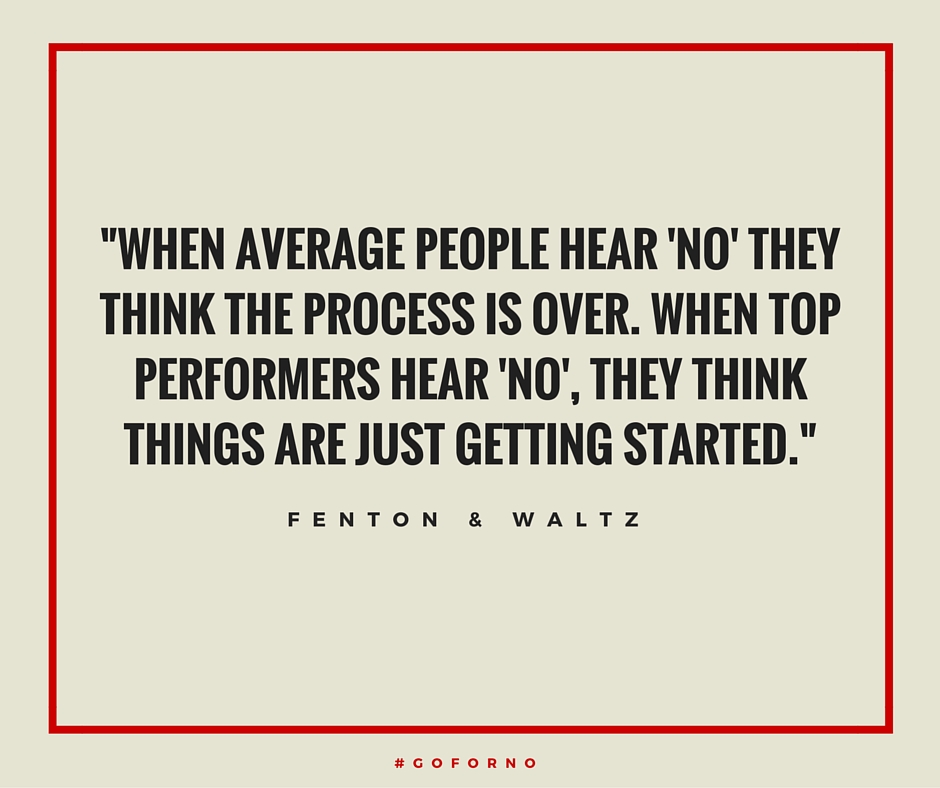
How do you go about qualifying prospects?
Andrea: In the gathering stage – that first contact– you establish if someone has a need or want for your service. In some cases, people will tell you they’re not ready but that’s still a qualified prospect. As long as they’ve expressed a need or want for the service you offer, then they’re still qualified.
If you call someone and asked if they need your services and they said they don’t because they closed their business and no longer need your service, then they’ve just unqualified themselves. But if someone has expressed a need for your service, even if they’re not ready yet, you’ve still found a qualified prospect. So overtime you follow up with them, unless they tell you some new piece of information, they’re still qualified.
And just because that lead has another service provider, doesn’t mean you can’t still go after that prospect– especially if that person isn’t happy with their current service provider.
How can you built the relationship when a prospect isn’t ready yet?
Andrea: You want to build that relationship by providing value. For example, let’s use the example of an account again. You may have a newsletter and include your tip of the month – some common mistake that people make when doing their own taxes. Prospects would see this and see you as very giving and helpful.
It comes back to providing value that puts you over the edge from their current provider even more than just a follow up. That follow up has to happen, but you can make it valuable by including an article that may be of interest to them.
Service providers can create content for very little money and time. That content helps prospects prospects to see you as an expert. That helps people feel that your company is trustworthy, that you understand their needs, and are able to help them solve that problem.
Education marketing is so key. You may have a prospect that you know could really benefit from your services. If you are able to prove to them what value you can give, you’re one step closer to winning that business.
I use the example of an accountant because I had an account tell me that they could save me $3000 a year on our taxes by going with them. So when you weigh that against the fee, you have nothing to lose. If you can show and demonstrate people the value you bring, it helps make that decision for them.
Remind people of the benefit you bring – whether it’s saving them time, frustration, or avoiding making a mistake in a specific area. This education-based marketing strategy helps nudge people to make a decision. Sometimes people need that – they need permission to make a decision and they’re just stuck or scared of change. Showing people value overpowers that fear of hesitation or change because they can see that tangible result.
How can salespeople get into the right headspace and prepare to go for no? Is there a certain number of ‘no’s you have to hear to overcome that fear?
Andrea: There’s no magic number because everyone’s anxiety around the issue is different. I suggest rewarding yourself for the acidity, not the outcome. Focus on the behaviour, not the result.
If you’re only focused on the ‘yes’ then you have this added pressure. Instead, what we suggest is to remove that fear and anxiety by telling yourself that you don’t know if they’ll say ‘yes’ but if you do your best at sharing your services and how you help people, and ask for an appointment, then let the chips fall where they may.
Understand that your value is not tied up in whether or not you get a ‘yes’ or a ‘no’. Reward yourself for the attempt and not just the result. When you do that, that hopefully increases the activity of prospecting because it’s not about being perfect or only getting the ‘yes’.
You have to change your mindset to realize that in order to get a ‘yes’ and be successful, you have to go through a certain number of ‘no’s and experience a few failures. The people that have booming businesses that prospect a lot have heard a fair amount of ‘no’s. But what they have done in that process is refined and gotten better, just by learning and doing it more. But if you’re never out there and prospect, then you’re never going to get over that fear of rejection. That’s why the small, bite-sized consistency everyday is important.
While you’re refining your pitch, in that process, you’re going to learn. The problem with most people is not about having a perfect quality presentation, it’s the quantity– they’re just not connecting with enough people, so they’re not moving through those numbers to get better results.
We teach people to set a ‘no’ goal. For example, they want to get 5 ‘no’s a week, knowing if they do that, the ‘yes’s will come up. The key is to avoid prejudging or making assumptions. If you bring back 10 business cards from a networking event, instead of trying to figure out which one will be a ‘yes’, call up all of them and let them decide whether or not they need your services.
This philosophy and strategy can be practiced in all areas of your life. Building that courage in other areas of your life and spill over into your business.
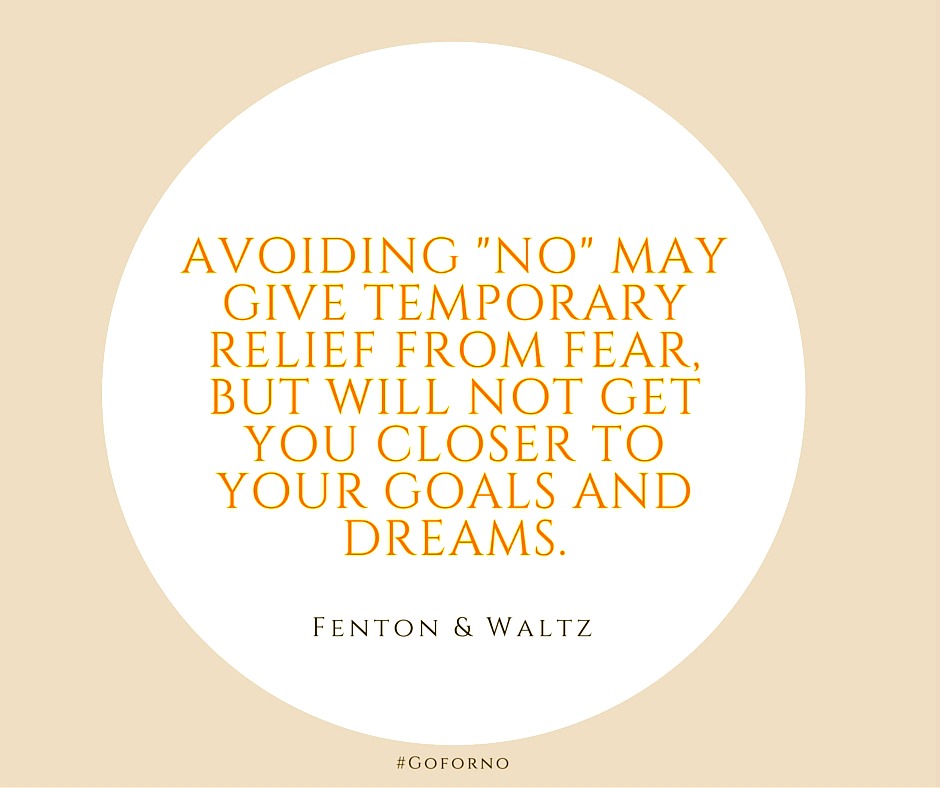
If you’re interested in learning more about the Go For No strategy, Andrea’s website Go For No, and connect with her on Facebook, LinkedIn, and Twitter @Goforno. You can also find her book Go For No! here.
